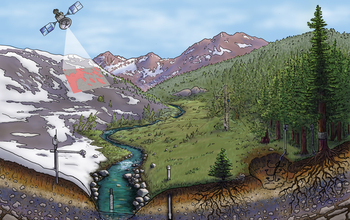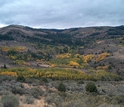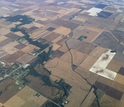 Credit and Larger Version |
The region between the top of the forest canopy and the base of weathered rock: our living environment and Earth's critical zone.
To provide a deeper understanding of that critical zone, the National Science Foundation (NSF) has selected sites for four new critical zone observatories (CZOs).
Scientists working at the new observatories--along with six existing NSF CZOs--will study the zone where rock meets life and its response to climate and land use changes.
The new CZOs are the Calhoun CZO in the Piedmont region of South Carolina; the Reynolds Creek CZO in Southwest Idaho; the Eel River CZO in Northern California; and the Intensively Managed Landscapes CZO in Illinois, Iowa and Minnesota.
The respective principal awardee institutions are Duke University; Idaho State University; the University of California, Berkeley; and the University of Illinois at Urbana-Champaign.
"The critical zone provides most of the ecosystem services on which society depends, such as clean water, food, nutrients, soil and carbon storage," says Roger Wakimoto, NSF assistant director for Geosciences.
"Researchers at the CZO sites are investigating the past evolution and present state of the critical zone," says Wakimoto, "to predict how Earth's surface will evolve in response to future human activity and to climate change.
"The results will provide the scientific basis for decision-making on how humans can best mitigate, adapt and respond to both slow and abrupt environmental changes."
The CZOs are the first network of systems-based observatories dedicated to Earth surface processes.
CZO scientists are investigating the integration and coupling of Earth surface processes, and how they are affected by the presence and flux of fresh water.
The researchers are using field and analytical methods, space-based remote sensing and theoretical techniques.
The CZOs add to the environmental sensor networks in place and planned by NSF, including EarthScope, the National Ecological Observatory Network and the Ocean Observatories Network.
Scientists have known that the critical zone is a complex system in which different components interact at various space and time scales, and in which the rates of processes depend on the nature of those interactions.
Until now, however, researchers have looked at the components individually, especially in the field. The CZOs allow for investigation of the critical zone as a holistic system, rather than as isolated parts.
The water cycle, the break-down of rocks and formation of soil, the geochemical and physical erosion of that soil, evolution of rivers and valleys, patterns of vegetation, and the form and function of the Earth are products of multiple interactive processes in the critical zone.
"More than half of Earth's landscapes are now affected by human forcings," says Daniel Richter of Duke University, principal investigator of the Calhoun CZO.
"These lands have a great deal of intrinsic resilience, but today they're experiencing unprecedented pressures," says Richter. "If we are to sustain food production, stabilize the carbon cycle and provide clean air and water and other ecosystem services for future generations, we need to better understand the land's sensitivities and thresholds."
Society has recognized the importance of water, soil, landforms and rivers to human welfare, but has only recently begun to holistically probe the workings of these coupled systems, CZO researchers believe.
"One of the major uncertainties in global climate models is how the large store of carbon in the soil may influence the atmosphere and climate," says Kathleen Lohse, principal investigator of the Reynolds Creek CZO. "A small change in that pool of carbon could have large effects on atmospheric concentrations."
Adds William Dietrich, principal investigator of the Eel River CZO, "In future uses of places like California's Eel River, we will see increasing demands on decreasing water resources.
"We need to look at how topography affects the return of moisture to the atmosphere and at hillslopes to understand atmospheric moisture, river flow and chemistry, ecosystem dynamics and coastal ocean productivity."
How hydrologic, physical, geochemical and biological processes interact to break down rocks, to form soil and to shape the landscape are significant questions in many scientific--and societal--problems, these researchers say.
"In the Midwest, humans have intensively modified the landscape over the last 200 years to make the prairie more capable of sustaining agriculture," says Praveen Kumar, principal investigator of the Intensively Managed Landscapes CZO.
"There is a reason this landscape is very productive, and when we modify it, we change its character," says Kumar. "We change how long water stays in soil versus going into a stream. We change how long nutrients and sediments stay on the landscape. What was wetland 200 years ago, we have modified to make agriculturally productive."
Scientists at NSF's CZOs are working to find answers to such questions as:
- How do landscapes evolve over human time scales and over millennia, and how is that process affected by the presence and flow of water?
- How do soil and weathered bedrock move down hillslopes, and how are they coupled to the evolution of channels that usually surround the bases of these hillslopes?
- How do biological processes affect physical processes?
- Are there signals in the landscape that can tell us about past climates and about how landscapes have responded--and might in the future--to climate change?
-NSF-
Media Contacts Cheryl Dybas, NSF, (703) 292-7734, cdybas@nsf.gov
Related WebsitesNSF Publication: Discoveries in the Critical Zone: Where Life Meets Rock: http://www.nsf.gov/pubs/2013/nsf13112/nsf13112.pdf
NSF Critical Zone Observatories Network:
NSF Critical Zone Observatories Network:
http://criticalzone.org/national/
NSF Award: Human and Natural Forcings of Critical Zone Dynamics and Evolution at the Calhoun Critical Zone Observatory:
NSF Award: Human and Natural Forcings of Critical Zone Dynamics and Evolution at the Calhoun Critical Zone Observatory:
http://www.nsf.gov/awardsearch/showAward?AWD_ID=1331846&HistoricalAwards=false
NSF Award: Reynolds Creek Carbon Critical Zone Observatory:
NSF Award: Reynolds Creek Carbon Critical Zone Observatory:
http://www.nsf.gov/awardsearch/showAward?AWD_ID=1331872&HistoricalAwards=false
NSF Award: The Eel River Critical Zone Observatory: exploring how the critical zone will mediate watershed currencies and ecosystem response in a changing environment:
NSF Award: The Eel River Critical Zone Observatory: exploring how the critical zone will mediate watershed currencies and ecosystem response in a changing environment:
http://www.nsf.gov/awardsearch/showAward?AWD_ID=1331940&HistoricalAwards=false
NSF Award: Critical Zone Observatory for Intensively Managed Landscapes (IML-CZO):
NSF Award: Critical Zone Observatory for Intensively Managed Landscapes (IML-CZO):
http://www.nsf.gov/awardsearch/showAward?AWD_ID=1331906&HistoricalAwards=false
NSF CZO Discovery Article: Earth Week: The Search for White Gold--Snowmelt:
NSF CZO Discovery Article: Earth Week: The Search for White Gold--Snowmelt:
The National Science Foundation (NSF) is an independent federal agency that supports fundamental research and education across all fields of science and engineering. In fiscal year (FY) 2012, its budget was $7.0 billion. NSF funds reach all 50 states through grants to nearly 2,000 colleges, universities and other institutions. Each year, NSF receives about 50,000 competitive requests for funding, and makes about 11,500 new funding awards. NSF also awards about $593 million in professional and service contracts yearly.
Useful NSF Web Sites:
NSF Home Page: http://www.nsf.gov
NSF News: http://www.nsf.gov/news/
For the News Media: http://www.nsf.gov/news/newsroom.jsp
Science and Engineering Statistics: http://www.nsf.gov/statistics/
Awards Searches: http://www.nsf.gov/awardsearch/
NSF Home Page: http://www.nsf.gov
NSF News: http://www.nsf.gov/news/
For the News Media: http://www.nsf.gov/news/newsroom.jsp
Science and Engineering Statistics: http://www.nsf.gov/statistics/
Awards Searches: http://www.nsf.gov/awardsearch/
 Scientists at the Critical Zone Observatories study Earth's surface: Where rock meets life.
Scientists at the Critical Zone Observatories study Earth's surface: Where rock meets life.Credit and Larger Version

Northern California's Eel River is one of the new CZO sites.Credit and Larger Version

An October view of the Reynolds Creek CZO site in southwest Idaho.Credit and Larger Version

The Intensively Managed Landscapes CZO site in Illinois-Iowa-Minnesota: much land-use change.Credit and Larger Version

A soon-to-be-upgraded watershed research site at the Calhoun CZO in the Southeast Piedmont.Credit and Larger Version
is an independent federal
The National Science Foundation (NSF)
Guillermo Gonzalo Sánchez Achutegui

No hay comentarios:
Publicar un comentario